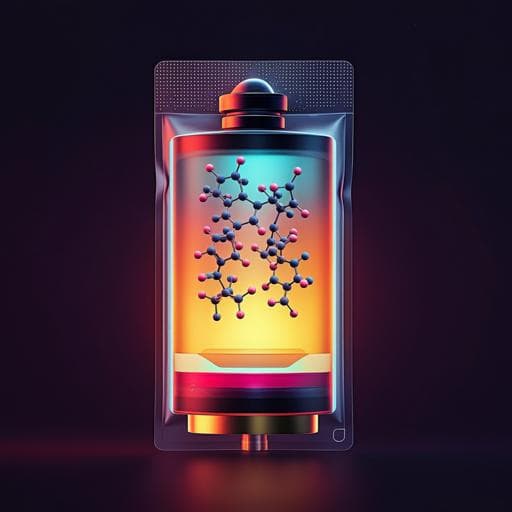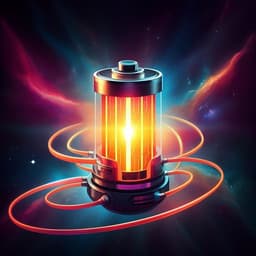
Engineering and Technology
A monofluoride ether-based electrolyte solution for fast-charging and low-temperature non-aqueous lithium metal batteries
G. Zhang, J. Chang, et al.
Discover how a new monofluoride ether electrolyte solvent enhances lithium metal battery performance without compromising oxidation stability. Researchers, including Guangzhao Zhang and Jian Chang from Southern University of Science and Technology, report impressive results—achieving a specific energy of 426 Wh kg⁻¹ and 80% capacity retention after 200 cycles.
~3 min • Beginner • English
Introduction
Lithium metal anodes are attractive for high-energy-density batteries due to their low redox potential and high theoretical capacity, yet conventional non-aqueous electrolytes suffer from instability against both Li metal and high-voltage cathodes, leading to dendritic deposition and electrolyte decomposition. These issues worsen under fast-charging and low-temperature conditions, where high ionic conductivity, wide electrochemical stability windows, low density, and high boiling point are required of the electrolyte. Fluorinated solvents can enhance oxidative stability by lowering solvent HOMO levels, but commonly reduce ionic conductivity and solvation capability, degrading rate and low-temperature performance. Carbonate-based fluorinated electrolytes are prone to reduction on Li metal, while fluorinated ethers are more compatible with Li but still exhibit reduced conductivity when highly fluorinated (difluoro/trifluoro). This work targets a balance: introducing a monofluoride substituent (-CH2F) to maximize Li+ coordination (via Li-F and Li-O tridentate interactions) without sacrificing oxidative stability, thereby enabling fast charging and wide-temperature operation in practical Li||NCM811 cells and pouch formats.
Literature Review
Multiple engineering strategies have been explored to stabilize high-voltage lithium metal batteries, including high-concentration and localized high-concentration electrolytes, additive-regulated systems, and fluorinated electrolytes. Fluorination lowers solvent HOMO levels, improving oxidative stability against high-voltage cathodes. However, difluoro- and trifluoro-substituted ether solvents withdraw electron density from coordinating oxygen atoms, weakening Li+ solvation, promoting ion aggregation, and reducing ionic conductivity. Prior work with fluorinated carbonates improved oxidation stability but suffered reduction at Li metal. Fluorinated ethers offer better Li compatibility, yet extensive fluorination still compromises conductivity and low-temperature/high-rate performance. Consequently, an electrolyte design that preserves oxidative stability while restoring strong Li+ coordination to boost ionic conductivity is needed.
Methodology
- Solvent design and synthesis: Monofluoride bis(2-fluoroethyl) ether (BFE) was designed to provide Li-F and Li-O tridentate coordination, with two methylene spacers to favor a five-member chelate with Li+. BFE was synthesized via one-step nucleophilic substitution of 2-fluoroethanol with 1-bromo-2-fluoroethane in N-methylpyrrolidone with KOH at -5 to 30 °C, purified by distillation (128–135 °C), water <10 ppm. Asymmetric DFE and TFEE, and BDE were also synthesized for comparison.
- Physicochemical characterization: Density and boiling point of BFE measured; viscosity and ionic conductivity measured vs salt concentration and temperature (FiveGo F3, rheometer). NMR (1H, 19F, 17O, 7Li) verified structure and probed coordination; Raman probed solvation structures; ESI-MS confirmed [solvent-Li+] complexes. LSV established oxidative stability; leakage current at constant voltage evaluated.
- Electrolyte preparation: LiFSI dissolved in BFE, DEE, DME to 0.5–2.5 M (typical 2 M in BFE for peak conductivity; 1 M for comparisons). TFEE solubility limited to ~0.2 M.
- Theoretical/computational: DFT (B3LYP/6-31G(d,p)) to compute molecular ESPs, HOMO levels, and solvating/binding energies for DEE, TFFE, DFE, BFE (and BTFE/BDE solubility observations). All-atom MD (GROMACS OPLS-AA) simulated 2 M LiFSI in DEE and BFE at 303 K and 243 K; RDFs, solvation cluster analysis (SSIP/CIP), and Li+ MSDs were obtained.
- Electrochemical tests: Li||Cu Coulombic efficiency via Aurbach protocol and galvanostatic CE at various temperatures (30 °C and -30 °C). Li||Li symmetric cells for rate/overpotential. Li||NCM811 coin cells (areal capacity 3.5 mAh cm−2, cutoff 2.8–4.4 V, N/P 2.8, lean electrolyte 2.4 g Ah−1) for rate and cycling at 30 °C and low temperatures down to -60 °C. Anode-free Cu||NCM811 and Li||graphite cells also evaluated. A 320 mAh Li||NCM811 multi-layer pouch cell (4 mAh cm−2 cathodes, N/P 2, 2.4 g Ah−1 electrolyte) assessed for specific energy and cycling.
- Ex situ interphase and morphology: SEM for Li deposition morphology and thickness; Cryo-TEM/FFT and EELS for SEI thickness and crystallography (LiF, Li2O); XPS depth profiling (F 1s, C 1s, O 1s, S 2p, N 1s) for SEI/CEI composition; HR-TEM and XPS for cathode CEI thickness and composition.
Key Findings
- Monofluoride solvent properties: BFE density 0.98 g cm−3 (30 °C) and boiling point 128 °C, both favorable vs DEE (34.5 °C boiling) and BTFE (63 °C). Reduced flammability indicated.
- Ionic conductivity and transport: 2 M LiFSI/BFE achieved 8 mS cm−1 at 30 °C; maintained 0.95–15 mS cm−1 from -60 to 70 °C with Li+ transference number ~0.69. BFE electrolytes outperformed DEE and DME across concentrations and temperatures. BTFE and BDE showed poor LiFSI solubility.
- Electrochemical stability: Oxidative stability window 4.7 V vs Li/Li+ (Li||Al LSV), up to 5.2 V in Li||Pt; lower leakage current at 4.4 V vs DEE. BFE HOMO lower than DEE (calculated), supporting oxidation stability.
- Coordination mechanism: DFT ESP maps show monofluoro (-CH2F) restores electron density at coordinating O and enables Li-F coordination. 19F NMR shows upfield shifts upon LiFSI dissolution (0.55 ppm for BFE), indicating strong monofluoride–Li+ interaction; 17O NMR and Raman confirm strong Li–O coordination. 7Li NMR shows most shielded Li in BFE (-1.24 ppm), consistent with strongest solvation; calculated solvating energies: DEE ~200 < TFFE ~225 < DFE ~250 < BFE ~325 kJ mol−1.
- Solvation structure: MD reveals BFE forms small, homogeneous clusters with prevalent SSIP and CIP structures; RDF shows strong Li–OBFE and Li–FBFE peaks near 2 Å. SSIP [2 BFE:Li+] accounts for ~40% of Li; CIP [2 BFE + FSI−] ~40%. Fast Li+ diffusion at 30 and -30 °C vs DEE.
- Li metal compatibility: Li||Cu average CE up to 99.75% at 0.5 mA cm−2, 1 mAh cm−2 (30 °C); low overpotential (~5 mV) vs DEE (~15 mV) and DME (~29 mV). At -30 °C, CE ~99.5% with ~15 mV overpotential (DEE ~98.8% and ~120 mV). Li||Li symmetric cells showed lower polarization across 0.5–10 mA cm−2.
- Full-cell performance (coin cells, NCM811, 3.5 mAh cm−2, 2.8–4.4 V, 30 °C): Specific capacities with BFE: 214, 202, 191, 179, 161, 148 mAh g−1 at 0.7, 1.75, 3.5, 7, 10.5, 17.5 mA cm−2, respectively. Capacity retention >80% after 300 cycles at 3.5 and 7 mA cm−2. Under practical conditions (N/P 2.8, lean electrolyte 2.4 g Ah−1), >90% capacity retention after 200 cycles at 30 °C.
- Low-temperature operation: Li||NCM811 with BFE delivered 90, 139, 160, 181, 202, 226 mAh g−1 at -60, -30, -20, 0, 30, 60 °C (0.35–1.75 mA cm−2). At -30 °C, >90% capacity retention over 150 cycles at 1.75 mA cm−2; DEE failed within ~50 cycles and DME solidified below -20 °C.
- Pouch cell (320 mAh): Specific energy 426 Wh kg−1 (total cell mass) at 0.4 mA cm−2; capacity retention >80% after 200 cycles at 0.7/7 mA cm−2 (30 °C). Abstract reports 80% after 200 cycles at 0.8/8 mA cm−2.
- Interphases: BFE yields smooth, compact Li deposits and thinner plated layers vs DME/DEE. SEI after cycling is dense and uniform (~18 nm), LiF- and Li2O-rich (LiF (200), Li2O (111)) with uniform LiF signal through depth (XPS F 1s). On NCM811, BFE forms a thin (<1 nm) LiF-rich CEI with fewer organics than DEE/DME.
Discussion
The study demonstrates that targeted monofluoro substitution in ether solvents enables simultaneous enhancement of ionic conductivity and oxidation stability—an uncommon combination for fluorinated electrolytes. The -CH2F group participates directly in Li+ coordination alongside ether oxygens, forming tridentate Li-F/Li-O complexes that strengthen solvation, reduce ion aggregation, and accelerate Li+ transport. This solvation chemistry persists across a wide temperature range and supports formation of favorable interphases: a thin, LiF-rich SEI on Li metal and a thin, LiF-rich CEI on NCM811. These interphases reduce overpotentials, suppress dendrites, and limit parasitic reactions at high voltage. Consequently, Li||NCM811 cells exhibit high-rate capability up to 17.5 mA cm−2, robust cycling at practical loadings with lean electrolyte and low N/P, and stable operation from -60 to 60 °C. The pouch-cell results underscore the practical relevance, delivering high specific energy at both moderate and high current densities. Overall, the findings address the key bottleneck (ionic conductivity loss upon fluorination) and provide a rational design route for industrial electrolytes for fast-charging and low-temperature high-voltage lithium batteries.
Conclusion
This work introduces a monofluoride ether solvent (BFE) that leverages Li-F and Li-O tridentate coordination to achieve high ionic conductivity, wide electrochemical stability, and excellent electrode compatibility. The single-salt/single-solvent BFE–LiFSI electrolyte attains 8 mS cm−1 at 30 °C, a 4.7–5.2 V oxidation window, high Li metal CE (up to 99.75%), robust interphases (LiF-rich SEI/CEI), and wide-temperature operation (-60 to 60 °C). High-loading Li||NCM811 coin cells and a 320 mAh pouch cell demonstrate high specific energies and durable cycling under practical constraints (lean electrolyte, low N/P) and at high rates. The monofluoride design principle provides a feasible pathway to fluorinated electrolytes that satisfy fast-charging and low-temperature requirements for high-voltage lithium batteries.
Limitations
Related Publications
Explore these studies to deepen your understanding of the subject.







